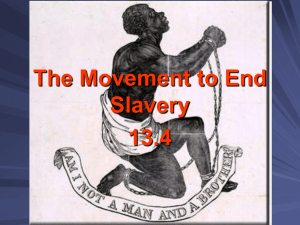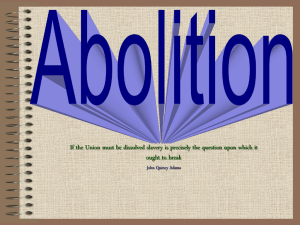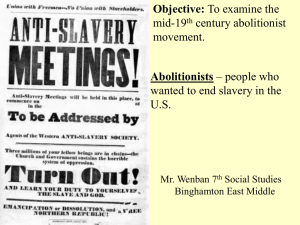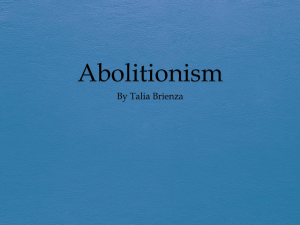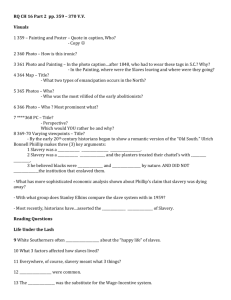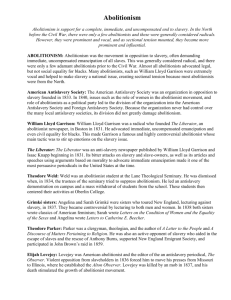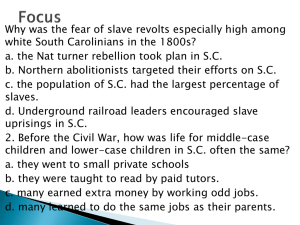Task - Social Studies - Grade 7
advertisement
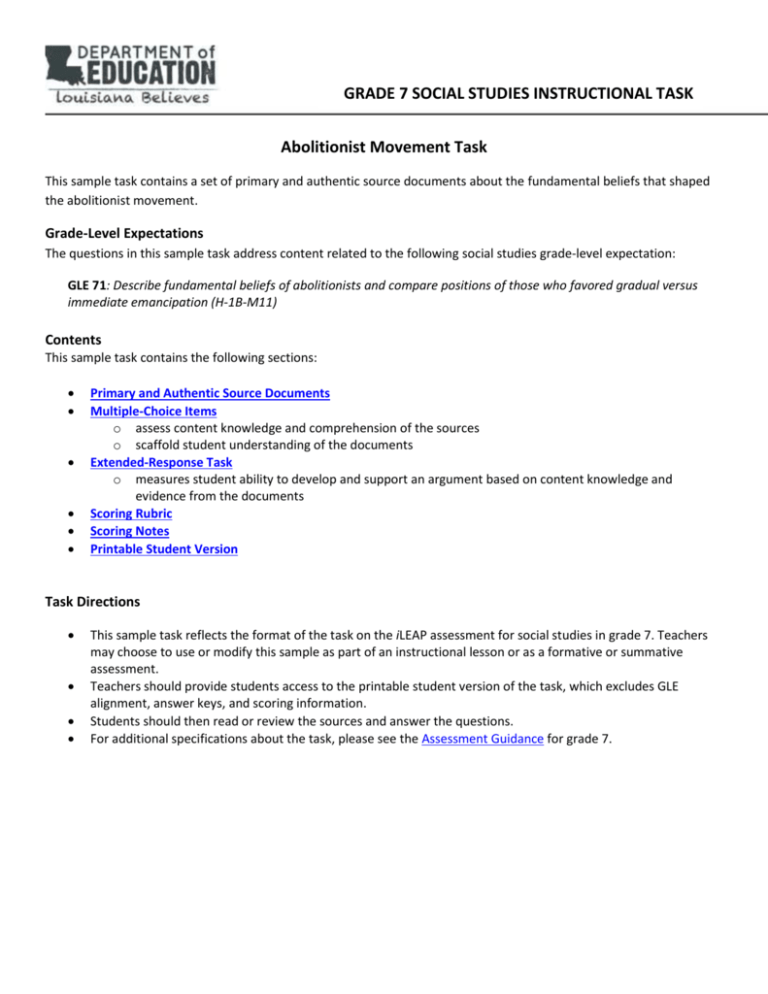
GRADE 7 SOCIAL STUDIES INSTRUCTIONAL TASK Abolitionist Movement Task This sample task contains a set of primary and authentic source documents about the fundamental beliefs that shaped the abolitionist movement. Grade-Level Expectations The questions in this sample task address content related to the following social studies grade-level expectation: GLE 71: Describe fundamental beliefs of abolitionists and compare positions of those who favored gradual versus immediate emancipation (H-1B-M11) Contents This sample task contains the following sections: Primary and Authentic Source Documents Multiple-Choice Items o assess content knowledge and comprehension of the sources o scaffold student understanding of the documents Extended-Response Task o measures student ability to develop and support an argument based on content knowledge and evidence from the documents Scoring Rubric Scoring Notes Printable Student Version Task Directions This sample task reflects the format of the task on the iLEAP assessment for social studies in grade 7. Teachers may choose to use or modify this sample as part of an instructional lesson or as a formative or summative assessment. Teachers should provide students access to the printable student version of the task, which excludes GLE alignment, answer keys, and scoring information. Students should then read or review the sources and answer the questions. For additional specifications about the task, please see the Assessment Guidance for grade 7. GRADE 7 SOCIAL STUDIES INSTRUCTIONAL TASK Primary and Authentic Source Documents Read and study Documents 1 through 4 about the abolitionist movement in the United States. As you read, you may take notes in the space next to the documents or on page XX in this answer document. Then use the documents to answer questions 1 through 5. Document 1: Declaration of Sentiments of the American Anti-Slavery Convention (1833) These are our views and principles—these our designs and measures. With entire confidence in the overruling justice of God, we plant ourselves upon the Declaration of our Independence and the truths of Divine Revelation, as upon the Everlasting Rock. We shall organize Anti-Slavery Societies, if possible, in every city, town and village in our land. We shall send forth agents to lift up the voice of remonstrance, of warning, of entreaty, and of rebuke. We shall circulate, unsparingly and extensively, anti-slavery tracts and periodicals. We shall enlist the pulpit and the press in the cause of the suffering and the dumb. We shall aim at a purification of the churches from all participation in the guilt of slavery. We shall encourage the labor of freemen rather than that of slaves, by giving a preference to their productions: and We shall spare no exertions nor means to bring the whole nation to speedy repentance. http://utc.iath.virginia.edu/abolitn/abeswlgct.html GRADE 7 SOCIAL STUDIES INSTRUCTIONAL TASK Document 2: The Emancipator (1838) Transcript The Emancipator – Extra. February 24th, 1838. Anti-Slavery Convention. The undersigned invite all the citizens of Connecticut friendly to the immediate emancipation of the slaves of our country, to send delegates to a Convention to be held at Hartford, on Wednesday, the 28th of February, 1838, in order to form a STATE ANTISLAVERY SOCIETY. Individuals in the State, and from other States, holding the principles of Anti-Slavery Societies, are also invited to attend the Convention. We propose the formation of a State Society, that our influence may be more efficient, and that the great cause in which we are engaged, may be carried on with more energy. We believe we have a right, and that it is our duty, to do all that we can, consistently with the Constitution and Laws, to abolish slavery in our land: we entertain no Utopian project of “letting loose” all the slaves: but we propose to have them placed under equal and just laws; to deliver them from the yoke of oppression, and give them liberty. We believe the system of slavery in our country ought to be abolished, because it is fraught with evil to the slave and the slave holder; and we believe it can be done, because it has been done in other countries, not only without injury, but with positive good to all parties. We believe it ought to be done because it is wrong in itself; contrary to human rights; and contrary to the spirit of the Bible. We believe that a state of things which forbids the reading of the Bible; which deprives men of property in themselves; which does not recognize the institution of marriage; which is continually rending asunder the most tender ties; and the habitual tendency of which is to degrade men to the condition of brutes, ought to be changed immediately. We know that we have no power, and no right to abrogate the laws of the slaveholding States; and we disclaim it. We do not propose to the slave, to arise, and vindicate his rights; but we propose the only course which will prevent it. The only means we wish to use are a moral influence; a concentration of public opinion; a diffusion of light and knowledge on the subject; which will convince and persuade our southern brethren that it is not only right for them to free the slaves, but that the best interests of our country require it. (Signatures) http://www.gilderlehrman.org/sites/default/files/inline-pdfs/Posters_0.pdf GRADE 7 SOCIAL STUDIES INSTRUCTIONAL TASK Document 3: “Tree of Slavery” (1850) http://historyproject.ucdavis.edu/ic/image_details.php?id=6598 GRADE 7 SOCIAL STUDIES INSTRUCTIONAL TASK Document 4: A Family Sold Apart (1838) http://www.memorialhall.mass.edu/collection/itempage.jsp?itemid=5756&level=advanced&transcription=0&img=14 GRADE 7 SOCIAL STUDIES INSTRUCTIONAL TASK Multiple-Choice Items History GLE 71: Describe fundamental beliefs of abolitionists and compare positions of those who favored gradual versus immediate emancipation (H-1B-M11) According to Document 1, which of these best describes the methods endorsed by the American Anti-Slavery Society? A to incite violence to achieve abolitionist goals B to promote morality to support the cause C to make exceptions as needed D to discourage consumer boycotts Correct response: B History GLE 71: Describe fundamental beliefs of abolitionists and compare positions of those who favored gradual versus immediate emancipation (H-1B-M11) 2 Based on Document 2, what are the abolitionists trying to prevent? A B C D a war between the North and South enslaved persons from becoming free slaves from revolting against their owners Connecticut from becoming a slave state Correct response: C History GLE 71: Describe fundamental beliefs of abolitionists and compare positions of those who favored gradual versus immediate emancipation (H-1B-M11) 3 Which of these would best summarize the practice of slavery as depicted in Document 3? A B C D It is necessary. It is constitutional. It is acceptable. It is unjust. Correct response: D GRADE 7 SOCIAL STUDIES INSTRUCTIONAL TASK History GLE 71: Describe fundamental beliefs of abolitionists and compare positions of those who favored gradual versus immediate emancipation (H-1B-M11) 4 Which is a reason why the abolitionists might have used images such as Document 4 to promote their cause? A B C D Many northerners were already aware of the practices related to slavery. Most southerners had attended slave auctions. People needed to see slaves as people rather than property. People needed to understand the importance of slavery to the southern economy. Correct response: C GRADE 7 SOCIAL STUDIES INSTRUCTIONAL TASK Extended-Response Task History GLE 71: Describe fundamental beliefs of abolitionists and compare positions of those who favored gradual versus immediate emancipation (H-1B-M11) 5 Write a well-organized response on the lines provided on pages XX and XX in this answer document. Describe the fundamental beliefs that shaped the abolitionist movement and at least 3 actions taken by abolitionists based on those beliefs. As you write, follow the directions below. Your response should have multiple paragraphs. Support your ideas with reasons, facts, and details. Use evidence from each of the documents. Include information and examples from your own knowledge of social studies. Be sure to write clearly. Use page XX in this answer document for notes and planning. Write your final response on pages XX and XX in this answer document. Remember: The prewriting activities on page XX will not be scored. Only your response on pages XX and XX will be scored. GRADE 7 SOCIAL STUDIES INSTRUCTIONAL TASK Scoring Rubric The response should be scored holistically on its historical analysis and content. Each response should be given the score that corresponds to the set of bulleted descriptors that best describes the response. Score 4 3 2 1 0 Task Rubric Grade 7—Abolitionism The student’s response constructs a sophisticated argument that o provides an in-depth description of the fundamental beliefs held by abolitionists, and o thoroughly describes tactics employed to promote the cause; supports the claims with ample, well-chosen evidence that o addresses or demonstrates understanding of four of the documents, and o integrates adequate relevant information beyond what is provided in the documents; contains valid historical understandings and interpretations with no errors significant enough to detract from the argument. The student’s response constructs an acceptable argument that o provides a general explanation of the fundamental beliefs held by abolitionists, and o generally describes examples of tactics employed to promote the cause; supports the claims with sufficient and appropriate evidence that o addresses or demonstrates understanding of three of the documents, and o integrates some relevant information beyond what is provided in the documents; contains mostly valid historical understandings and interpretations, although less important ideas or details may be overlooked or misunderstood. The student’s response constructs a weak and/or flawed argument that o provides a limited or partial explanation of the fundamental beliefs held by abolitionists, and o partially describes examples of tactics employed to promote the cause; supports the claims with limited and/or uneven evidence that o addresses or demonstrates understanding of two of the documents, and o integrates limited relevant information beyond what is provided in the documents; contains some valid historical understandings and interpretations, but a few significant errors may be present. The student’s response must include at least one valid historical understanding or interpretation that addresses the prompt and is stated in the student’s own words; must demonstrate a minimal understanding of the topic; may contain several significant errors. The student’s response is incorrect, irrelevant, or too brief to evaluate. GRADE 7 SOCIAL STUDIES INSTRUCTIONAL TASK Scoring Notes A strong response references all four documents appropriately: o the various tactics employed to promote the cause of abolition (Document 1) o the reasoning behind the abolitionist movement (Document 2) o abolitionists’ beliefs about slavery (Document 3) o families of slaves were often separated (Document 4) o the practice of buying and selling slaves as property (Document 4) applies the provided evidence as well as additional information about the abolitionist movement, for example: o the various tactics employed to promote the cause of abolition organizing anti-slavery groups publications speeches consumer boycotts riots church involvement o the beliefs that framed the rationale behind the abolitionist movement cruelty immorality inequality o the fact that families of enslaved persons were often separated by being sold to different masters Printable Student Version *Note: Some sources are available only in digital format. A link is provided and will require the use of a computer to view the source. Abolitionist Movement Task Read and study Documents 1 through 4 about the abolitionist movement in the United States. As you read, you may take notes in the space next to the documents or on page 7 in this answer document. Then use the documents to answer questions 1 through 5. Document 1: Declaration of Sentiments of the American Anti-Slavery Convention (1833) These are our views and principles—these our designs and measures. With entire confidence in the overruling justice of God, we plant ourselves upon the Declaration of our Independence and the truths of Divine Revelation, as upon the Everlasting Rock. We shall organize Anti-Slavery Societies, if possible, in every city, town and village in our land. We shall send forth agents to lift up the voice of remonstrance, of warning, of entreaty, and of rebuke. We shall circulate, unsparingly and extensively, anti-slavery tracts and periodicals. We shall enlist the pulpit and the press in the cause of the suffering and the dumb. We shall aim at a purification of the churches from all participation in the guilt of slavery. We shall encourage the labor of freemen rather than that of slaves, by giving a preference to their productions: and We shall spare no exertions nor means to bring the whole nation to speedy repentance. http://utc.iath.virginia.edu/abolitn/abeswlgct.html 1 Document 2: The Emancipator (1838) Transcript The Emancipator – Extra. February 24th, 1838. Anti-Slavery Convention. The undersigned invite all the citizens of Connecticut friendly to the immediate emancipation of the slaves of our country, to send delegates to a Convention to be held at Hartford, on Wednesday, the 28th of February, 1838, in order to form a STATE ANTISLAVERY SOCIETY. Individuals in the State, and from other States, holding the principles of Anti-Slavery Societies, are also invited to attend the Convention. We propose the formation of a State Society, that our influence may be more efficient, and that the great cause in which we are engaged, may be carried on with more energy. We believe we have a right, and that it is our duty, to do all that we can, consistently with the Constitution and Laws, to abolish slavery in our land: we entertain no Utopian project of “letting loose” all the slaves: but we propose to have them placed under equal and just laws; to deliver them from the yoke of oppression, and give them liberty. We believe the system of slavery in our country ought to be abolished, because it is fraught with evil to the slave and the slave holder; and we believe it can be done, because it has been done in other countries, not only without injury, but with positive good to all parties. We believe it ought to be done because it is wrong in itself; contrary to human rights; and contrary to the spirit of the Bible. We believe that a state of things which forbids the reading of the Bible; which deprives men of property in themselves; which does not recognize the institution of marriage; which is continually rending asunder the most tender ties; and the habitual tendency of which is to degrade men to the condition of brutes, ought to be changed immediately. We know that we have no power, and no right to abrogate the laws of the slaveholding States; and we disclaim it. We do not propose to the slave, to arise, and vindicate his rights; but we propose the only course which will prevent it. The only means we wish to use are a moral influence; a concentration of public opinion; a diffusion of light and knowledge on the subject; which will convince and persuade our southern brethren that it is not only right for them to free the slaves, but that the best interests of our country require it. (Signatures) http://www.gilderlehrman.org/sites/default/files/inline-pdfs/Posters_0.pdf 2 Document 3: “Tree of Slavery” (1850) http://historyproject.ucdavis.edu/ic/image_details.php?id=6598 3 Document 4: A Family Sold Apart (1838) http://www.memorialhall.mass.edu/collection/itempage.jsp?itemid=5756&level=advanced&transcription=0&img=14 4 1 Which of these best describes the methods endorsed by the American Anti-Slavery Society in Document 1? A B C D 2 Based on Document 2, what are the abolitionists trying to prevent? A B C D 3 a war between the North and South enslaved persons from becoming free slaves from revolting against their owners Connecticut from becoming a slave state Which of these would best summarize the practice of slavery as depicted in Document 3? A B C D 4 to incite violence to achieve abolitionist goals to promote morality to support the cause to make exceptions as needed to discourage consumer boycotts It is necessary. It is constitutional. It is acceptable. It is unjust. Which is a reason why the abolitionists might have used images such as Document 4 to promote their cause? A B C D Many northerners were already aware of the practices related to slavery. Most southerners had attended slave auctions. People needed to see slaves as people rather than property. People needed to understand the importance of slavery to the southern economy. 5 5 Write a well-organized response on the lines provided on pages 8 and 9 in this answer document. Describe the fundamental beliefs that shaped the abolitionist movement and analyze the impact of the actions taken by abolitionists. As you write, follow the directions below. Your response should have multiple paragraphs. Support your ideas with reasons, facts, and details. Use evidence from each of the documents. Include information and examples from your own knowledge of social studies. Be sure to write clearly. Use page 7 in this answer document for notes and planning. Write your final response on pages 8 and 9 in this answer document. Remember: The prewriting activities on page 7 will not be scored. Only your response on pages 8 and 9 will be scored. 6 Use for notes and planning your response. (This page will not be scored.) 7 5. Final Response 8 9
